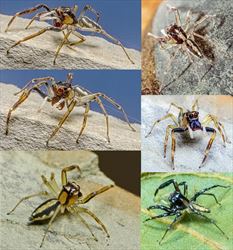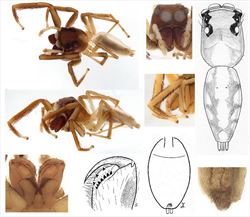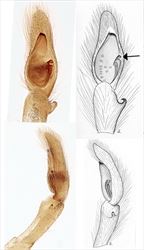
Examples of live Tauala
Illustrators (and ©) I.R. Macaulay, R. Whyte (BR)

Aspects of the general morphology of Tauala
Illustrators (and ©) B.J. Richardson (CSIRO), M. Zabka (diag.) (QMB)

Palp morphology of Tauala
Illustrators (and ©) B.J. Richardson (CSIRO), M. Zabka (diag.) (QMB)

Epigyne morphology of Tauala
Illustrators (and ©) R. Whyte, M. Zabka (diag.) (QMB)
Tauala Wanless, 1988
Taxonomy
Tauala has thirteen species: Tauala alveolatus, T. athertonensis, T. australiensis, T. bilobatus T. daviesae, T. lepidus, T. minutus, T. ottoi, T. palumaensis, T. setosus, T. splendidus, T. zborowskii from Australia and Tauala elongata from Taiwan which is probably misplaced in this genus (Żabka & Patoleta 2015). The genus is part of an Australasian clade (Maddison et al 2008) including Adoxotoma, Arasia, Astia, Astilodes, Helpis, Jacksonoides, Megaloastia, Parahelpis and Sondra. Genera from Indonesia (Katya) and the Philippines (Orthrus) may also be part of this group (Maddison 2015). Further information on the genus and described species can be found in Richardson and Żabka (2017) and Whyte and Anderson (2017).
Description
Tauala spp. are small to medium-sized spiders, ranging in body length from 2 to 7 mm. The head, viewed from above, is mildly pear-shaped, widest behind the posterior lateral eyes. The carapace is high, peaking at the posterior median eyes and immediately sloping to the rear. Chelicerae have a many-cusped (fissident) retromarginal tooth and two or three promarginal teeth. The abdomen is long and narrow. The tracheal spiracle is sometimes accompanied by a patch of dark, stiff setae. The first pair of legs is a little longer and heavier than the others; in males these legs sometimes have ventral and dorsal fringes of setae.
The male’s palp has a minute or small embolus arising on the distal edge of the tegulum. The tegulum is pear-shaped, without a proximal lobe, sometimes with a retro-lateral tegular apophysis. The palpal tibia has a single, hooked retro-lateral tibial apophysis, sometimes bi-lobate.
The female epigyne is simple, elongate and usually bordered by lightly-sclerotised margins, sometimes with a posterior pocket. The copulatory openings are slit-like edges. The insemination ducts are usually long and slender and lead posteriorly in a wavy or bent curve to join the round spermathecae located near the posterior edge of the epigyne. There are often distinctive accessory glands opening laterally off the insemination ducts.
Biology
Tauala is found on foliage, tree-trunks and on the ground in rainforest.
Distribution
Tauala occurs in the wetter areas of north-eastern Australia, mostly in Queensland but also in northern New South Wales.
References
Davies, V.T. & Żabka, M. 1989. Illustrated keys to the genera of jumping spiders (Araneae: Salticidae) in Australia. Memoirs of the Queensland Museum 27, 189-266.
Gardzińska, J. & Żabka, M. 2010. A new genus and five new species of Astieae (Araneae: Salticidae) from Australia, with remarks on distribution. Zootaxa 2526: 37-53.Maddison, W.P. 2015. A phylogenetic classification of jumping spiders (Araneae: Salticidae). Journal of Arachnology 43, 231-292.
Maddison, W.P., Bodner, M.R. & Needham, K.M. 2008. Salticid spider phylogeny revisited, with the discovery of a large Australian clade (Araneae: Salticidae). Zootaxa 1893, 49-64.
Richardson, B.J. & Żabka, M. 2017. Salticidae. Arachnida: Araneomorphae. Canberra, Australian Faunal Directory. Australian Biological Resources Study, at https://biodiversity.org.au/afd/taxa/SALTICIDAE.
Wanless, F.R. 1988. A revision of the spider group Astieae in the Australian Region. New Zealand Journal of Zoology 15, 81-172.
Whyte, R. & Anderson, G. 2017. A field guide to the spiders of Australia. Clayton: CSIRO Publishing 451pp.
Żabka, M. & Patoleta, B.M. 2015. New species of Tauala Wanless, 1988 from Australia (Araneae: Salticidae: Astioida: Astiae), with a redefinition of the genus. Zootaxa 4000. 501-517.
* The information sheet should be read in the context of the associated diagrams and photographs. Diagrams explaining anatomical terms can be found in the ‘Salticidae’ pictures at the beginning of the list of genera.